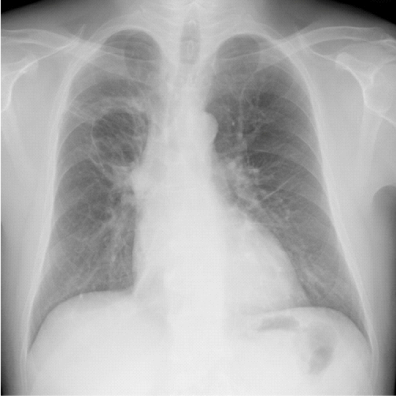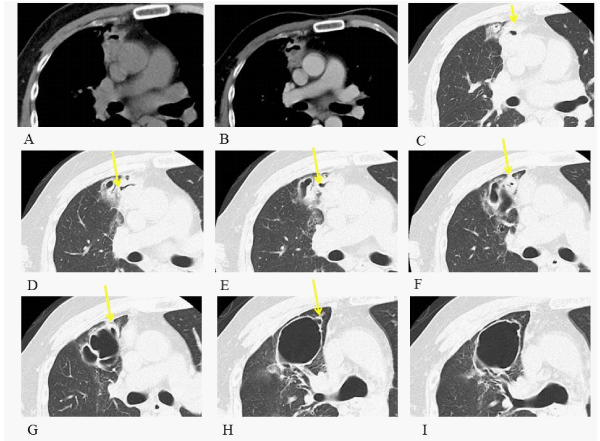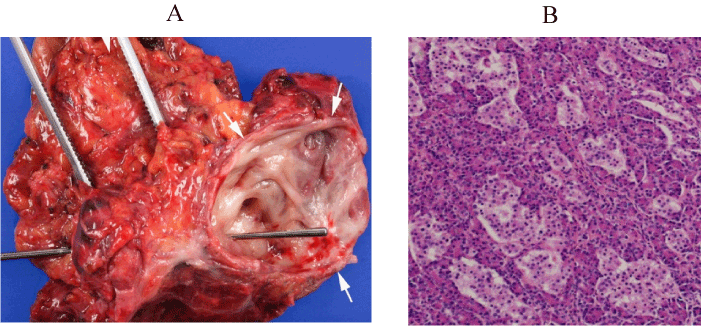Make the best use of Scientific Research and information from our 700+ peer reviewed, Open Access Journals that operates with the help of 50,000+ Editorial Board Members and esteemed reviewers and 1000+ Scientific associations in Medical, Clinical, Pharmaceutical, Engineering, Technology and Management Fields.
Meet Inspiring Speakers and Experts at our 3000+ Global Conferenceseries Events with over 600+ Conferences, 1200+ Symposiums and 1200+ Workshops on Medical, Pharma, Engineering, Science, Technology and Business
Case Report Open Access
Lung Perforation by a Mediastinal Teratoma with CT Evidence of a Fistula between the Tumor and Bronchus-Case Report
| Kurinobu T1, Sonoda A2*, Nitta N2, Otani H2, Kitamura S4, Nagatani Y2, Mukaisho K3, Tezuka N4, Nakano Y5, Takahashi M2 and Murata K2 | |
| 1Department of Diagnostic and Interventional Radiology, Aichi Cancer Center, 1-1, Kanokoden, Chikusa-ku, 464-8681, Japan | |
| 2Department of Radiology, Shiga University of Medical Science, Setatsukinowa-cho, Otsu, Shiga 520-2192, Japan | |
| 3Department of Pathology, Shiga University of Medical Science, Setatsukinowa-cho, Otsu, Shiga 520-2192, Japan | |
| 4Department of Thoracic Surgery, Shiga University of Medical Science, Setatsukinowa-cho, Otsu, Shiga 520-2192, Japan | |
| 5Department of Respiratory Tract Medicine, Shiga University of Medical Science, Setatsukinowa-cho, Otsu, Shiga 520-2192, Japan | |
| Corresponding Author : | Sonoda A Department of Radiology Shiga University of Medical Science Setatsukinowa-cho, Otsu, Shiga 520-2192, Japan Tel: 081-077-548-2288 Fax: 081-077-544-0986 E-mail: akinaga@belle.shiga-med.ac.jp |
| Received April 08, 2013; Accepted May 21, 2013; Published May 27, 2013 | |
| Citation: Kurinobu T, Sonoda A, Nitta N, Otani H, Kitamura S, et al. (2013) Lung Perforation by a Mediastinal Teratoma with CT Evidence of a Fistula between the Tumor and Bronchus-Case Report. OMICS J Radiology 2:129. doi: 10.4172/2167-7964.1000129 | |
| Copyright: © 2013 Kurinobu T, et al. This is an open-access article distributed under the terms of the Creative Commons Attribution License, which permits unrestricted use, distribution, and reproduction in any medium, provided the original author and source are credited. | |
Visit for more related articles at Journal of Radiology
| Introduction |
| Patients with ruptured mediastinal teratomas perforating into the lung have been reported [1,2]. Usually these teratomas are associated with severe symptoms such as pleural effusion, pneumonia, fever, and hemoptysis [3-6] although some elicit no- or mild symptoms [1,7]. In such cases chronic infection such as concomitant pulmonary infection or tuberculosis may contribute to the differential diagnosis [7]. The English language literature contains few reports of mediastinal teratomas perforating into the lung [1,2]. Because of their malignant potential their image patterns must be better understood. |
| We present a patient whose mediastinal germ cell tumor perforating into the lung elicited mild symptoms. A teratoma-bronchial fistula was clearly demonstrated on CT images. |
| Case Report |
| This 53-year old man with a history of persistent hemosputum was admitted for mitral valve surgery. At the age of 32 he was diagnosed with a pulmonary abscess. His blood pressure, heart rate, and body temperature were 116/66 mmHg, 68 bpm, and 36.8°C, respectively. His breath sounds were clear, CRP was 0.74 mg/dl, WBC was 11400/ μl. Beta-D glucan and Aspergillus species antigen levels were normal. Other laboratory findings were also normal. |
| A chest roentgenogram revealed a large mass with a cavity in the right upper lung (Figure 1). There was neither pleural effusion nor consolidation or ground glass opacity. A chest Computed Tomography (CT) scan showed a mediastinal mass measuring approximately 3.0 cm with a small air cavity (Figure 2A). There was some calcification at its periphery. The mass was enhanced heterogeneously and exhibited an unenhanced area suggestive of a fluid component (Figure 2B). No fatty component was identified. There was no pleural-or pericardial effusion near the tumor. The mediastinal mass was adjacent to a cystic lung lesion with a thickened wall in the right upper lobe. On axial CT images the air cavity of the mediastinal tumor was connected to the cystic lesion in the lung and tracheobronchial tree (Figures 2C-2I). |
| Cardiac and thoracic surgeons performed plastic surgery to the mitral valve, mediastinal tumor resection, and partial right upper lobectomy in one operative session. Intraoperatively a mediastinal tumor in front of the superior vena cava was identified. It infiltrated slightly into the parietal pleura and pericardium. A tumor at the anterior mediastinum with tight adherence to the lung surface of the upper lobe was also observed. The right internal mammary artery fed the mediastinal mass. |
| Histopathologically the mediastinal tumor with a fistula to the tracheobronchial tree was composed of hair, mature pancreatic- and intestinal tract tissue, endocrine-, exocrine-, and sebaceous gland tissue, thymic tissue, and skin (Figure 3). There were no immature or malignant components. The lung cystic lesion showed squamous and airway epithelia. Micro-inflammation and fibrosis were observed in the peribronchial area and bronchialectasis was identified. Perforation into the lung of the mediastinal germ cell tumor was confirmed and no immature components or malignancy were identified. |
| Discussion |
| Mediastinal germ cell tumors comprise 15% of anterior mediastinal tumors and 60% of mediastinal germ-cell tumors are benign teratomas in adults [8]. They often rupture into adjacent organs and factors leading to their rupture are controversial. Proposed mechanisms of tumor rupture are autolysis by digestive or proteolytic enzymes released from glandular-type tissues within the tumor (e.g. pancreatic tissues, salivary gland tissues, intestinal epithelium), inflammation elicited by sebaceous gland secretions, ischemia secondary to rapid tumor growth, pressure necrosis, and superimposed infection of pulmonary or hematologic origin [3,7]. |
| As the tumor in our patient contained pancreatic tissues we posit that pancreatic enzymes were involved in its rupture. This hypothesis is supported by his harboring a lung abscess 20 years earlier. The abscess was the result of chemical pneumonitis or attributable to a tumor that had infiltrated the lung via digestive enzymes. |
| Ruptured mediastinal teratomas may elicit various symptoms and critical complications. They produce pulmonary inflammation, pleuritis, pneumothorax, cardiac tamponade, and perforation of the greater vessels. Generally, ruptured mediastinal teratomas are associated with severe symptoms such as pleural effusion, pneumonia, fever, and hemoptysis [3-6] although in some instances the symptoms may be mild. In such cases the differential diagnosis involves chronic infection, for example concomitant pulmonary infection and tuberculosis [7]. Radiographic findings may suggest rupture of a mediastinal teratoma. As ruptured teratomas have malignant potential, the image patterns of mediastinal teratomas perforating into the lung must be understood. Radiographically, anterior mediastinal teratomas are visualized as well-defined round or lobulated masses composed of a combination of calcification, fat, fluid, and attenuated soft tissue. In many unruptured teratomas these components are homogeneously enhanced. On the other hand, enhancement is inhomogeneous in the presence of a ruptured teratoma [6]. Rupture results in chemical pneumonitis, pleural effusion, and sometimes abscess formation. The presence of specific components such as fat and calcification may be unclear. In our case we observed an inhomogeneously enhanced mass with calcification; no fat component was evident on CT images. |
| We posit that the lung cystic lesion in our patient resulted from drainage of the abscess through the bronchus rather than from chronic pulmonary infection with a fungus or from tuberculosis. The image patterns of spontaneously ruptured mediastinal teratomas must be better understood and at the interpretation of radiographic images, the possibility of spontaneous rupture of a mediastinal teratoma must be considered even in the presence of only mild symptoms. |
References |
|
Figures at a glance
 |
 |
 |
| Figure 1 | Figure 2 | Figure 3 |
Post your comment
Relevant Topics
- Abdominal Radiology
- AI in Radiology
- Breast Imaging
- Cardiovascular Radiology
- Chest Radiology
- Clinical Radiology
- CT Imaging
- Diagnostic Radiology
- Emergency Radiology
- Fluoroscopy Radiology
- General Radiology
- Genitourinary Radiology
- Interventional Radiology Techniques
- Mammography
- Minimal Invasive surgery
- Musculoskeletal Radiology
- Neuroradiology
- Neuroradiology Advances
- Oral and Maxillofacial Radiology
- Radiography
- Radiology Imaging
- Surgical Radiology
- Tele Radiology
- Therapeutic Radiology
Recommended Journals
Article Tools
Article Usage
- Total views: 13845
- [From(publication date):
July-2013 - Mar 29, 2025] - Breakdown by view type
- HTML page views : 9292
- PDF downloads : 4553
